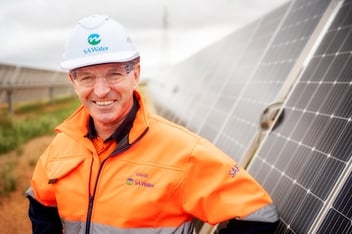Sunshine set to power South Australia’s water operations
Around 1300 solar photovoltaic panels are now helping to power SA Water’s drinking water operations on the Eyre Peninsula.
The installation is part of the utility’s Zero Cost Energy Future initiative, which includes the installation of 154 MW worth of solar photovoltaics at 35 sites, including 34 MWh of energy storage devices, by the end of 2020.
Installed at SA Water sites in Port Lincoln, Kimba, Lock, Arno Bay and Caralue Bluff, the roof and ground-mounted panels are among 500,000 panels to generate 242 GWh of electricity.
SA Water Senior Manager Zero Cost Energy Future Nicola Murphy said the new Eyre Peninsula solar arrays will produce a combined 770 MWh of green energy annually.
“Now capturing the Eyre Peninsula’s winter sun and supplying electricity to power our storage tanks, pump stations and Port Lincoln depot, these solar arrays are well positioned to make the most of high solar radiance during the brilliant Port Lincoln summers,” Murphy said.
“This focus on green energy will also deliver positive environmental benefits, with the power generated by solar the equivalent to reducing carbon emissions by around 340 tonnes annually.”
Murphy said disruptions from the coronavirus pandemic have not slowed down installation and the project has been delivered on time.
“Despite COVID-19, we’ve been able to complete our EP solar sites because we had the solar panels ready to go, and followed the guidelines for delivery of construction programs,” she said.
“It’s a great outcome, which has kept our contracting partners and suppliers in jobs working on large-scale projects that have flow-on benefits to the South Australian economy while supporting local Eyre Peninsula businesses.”
SA Water is one of South Australia’s largest energy users, with potable and wastewater pumping and treatment operations costing $83 million in 2018-19.
“This initiative was designed by our people, and is a demonstration of South Australians leading the way to strategically integrate renewable energy and storage within the longest water network in the country,” Murphy said.

